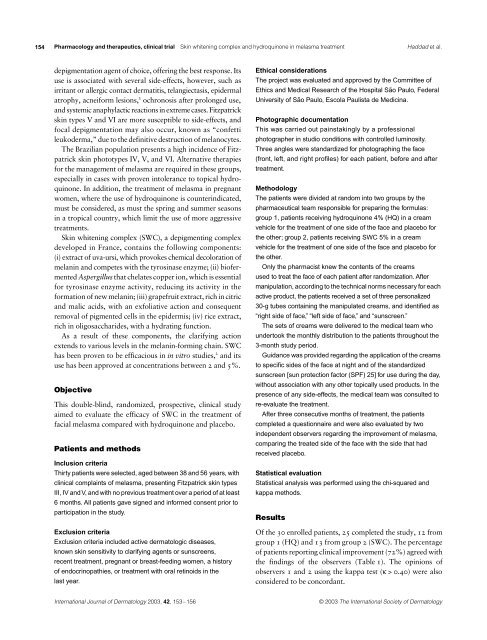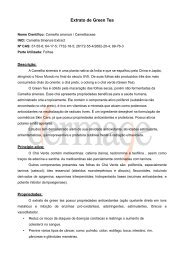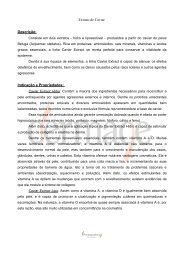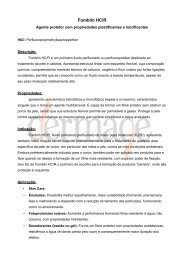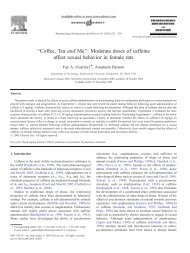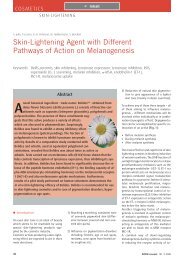Pharmacology and therapeutics, clinical trial - Dermage
Pharmacology and therapeutics, clinical trial - Dermage
Pharmacology and therapeutics, clinical trial - Dermage
Create successful ePaper yourself
Turn your PDF publications into a flip-book with our unique Google optimized e-Paper software.
154 <strong>Pharmacology</strong> <strong>and</strong> <strong>therapeutics</strong>, <strong>clinical</strong> <strong>trial</strong><br />
depigmentation agent of choice, offering the best response. Its<br />
use is associated with several side-effects, however, such as<br />
irritant or allergic contact dermatitis, telangiectasis, epidermal<br />
2<br />
atrophy, acneiform lesions, ochronosis after prolonged use,<br />
<strong>and</strong> systemic anaphylactic reactions in extreme cases. Fitzpatrick<br />
skin types V <strong>and</strong> VI are more susceptible to side-effects, <strong>and</strong><br />
focal depigmentation may also occur, known as “confetti<br />
leukoderma,” due to the definitive destruction of melanocytes.<br />
The Brazilian population presents a high incidence of Fitzpatrick<br />
skin phototypes IV, V, <strong>and</strong> VI. Alternative therapies<br />
for the management of melasma are required in these groups,<br />
especially in cases with proven intolerance to topical hydroquinone.<br />
In addition, the treatment of melasma in pregnant<br />
women, where the use of hydroquinone is counterindicated,<br />
must be considered, as must the spring <strong>and</strong> summer seasons<br />
in a tropical country, which limit the use of more aggressive<br />
treatments.<br />
Skin whitening complex (SWC), a depigmenting complex<br />
developed in France, contains the following components:<br />
(i) extract of uva-ursi, which provokes chemical decoloration of<br />
melanin <strong>and</strong> competes with the tyrosinase enzyme; (ii) biofermented<br />
Aspergillus that chelates copper ion, which is essential<br />
for tyrosinase enzyme activity, reducing its activity in the<br />
formation of new melanin; (iii) grapefruit extract, rich in citric<br />
<strong>and</strong> malic acids, with an exfoliative action <strong>and</strong> consequent<br />
removal of pigmented cells in the epidermis; (iv) rice extract,<br />
rich in oligosaccharides, with a hydrating function.<br />
As a result of these components, the clarifying action<br />
extends to various levels in the melanin-forming chain. SWC<br />
2<br />
has been proven to be efficacious in in vitro studies, <strong>and</strong> its<br />
use has been approved at concentrations between 2 <strong>and</strong> 5%.<br />
Objective<br />
This double-blind, r<strong>and</strong>omized, prospective, <strong>clinical</strong> study<br />
aimed to evaluate the efficacy of SWC in the treatment of<br />
facial melasma compared with hydroquinone <strong>and</strong> placebo.<br />
Patients <strong>and</strong> methods<br />
Inclusion criteria<br />
Thirty patients were selected, aged between 38 <strong>and</strong> 56 years, with<br />
<strong>clinical</strong> complaints of melasma, presenting Fitzpatrick skin types<br />
III, IV <strong>and</strong> V, <strong>and</strong> with no previous treatment over a period of at least<br />
6 months. All patients gave signed <strong>and</strong> informed consent prior to<br />
participation in the study.<br />
Exclusion criteria<br />
Exclusion criteria included active dermatologic diseases,<br />
known skin sensitivity to clarifying agents or sunscreens,<br />
recent treatment, pregnant or breast-feeding women, a history<br />
of endocrinopathies, or treatment with oral retinoids in the<br />
last year.<br />
Skin whitening complex <strong>and</strong> hydroquinone in melasma treatment<br />
Ethical considerations<br />
Haddad et al.<br />
The project was evaluated <strong>and</strong> approved by the Committee of<br />
Ethics <strong>and</strong> Medical Research of the Hospital São Paulo, Federal<br />
University of São Paulo, Escola Paulista de Medicina.<br />
Photographic documentation<br />
This was carried out painstakingly by a professional<br />
photographer in studio conditions with controlled luminosity.<br />
Three angles were st<strong>and</strong>ardized for photographing the face<br />
(front, left, <strong>and</strong> right profiles) for each patient, before <strong>and</strong> after<br />
treatment.<br />
Methodology<br />
The patients were divided at r<strong>and</strong>om into two groups by the<br />
pharmaceutical team responsible for preparing the formulas:<br />
group 1, patients receiving hydroquinone 4% (HQ) in a cream<br />
vehicle for the treatment of one side of the face <strong>and</strong> placebo for<br />
the other; group 2, patients receiving SWC 5% in a cream<br />
vehicle for the treatment of one side of the face <strong>and</strong> placebo for<br />
the other.<br />
Only the pharmacist knew the contents of the creams<br />
used to treat the face of each patient after r<strong>and</strong>omization. After<br />
manipulation, according to the technical norms necessary for each<br />
active product, the patients received a set of three personalized<br />
30-g tubes containing the manipulated creams, <strong>and</strong> identified as<br />
“right side of face,” “left side of face,” <strong>and</strong> “sunscreen.”<br />
The sets of creams were delivered to the medical team who<br />
undertook the monthly distribution to the patients throughout the<br />
3-month study period.<br />
Guidance was provided regarding the application of the creams<br />
to specific sides of the face at night <strong>and</strong> of the st<strong>and</strong>ardized<br />
sunscreen [sun protection factor (SPF) 25] for use during the day,<br />
without association with any other topically used products. In the<br />
presence of any side-effects, the medical team was consulted to<br />
re-evaluate the treatment.<br />
After three consecutive months of treatment, the patients<br />
completed a questionnaire <strong>and</strong> were also evaluated by two<br />
independent observers regarding the improvement of melasma,<br />
comparing the treated side of the face with the side that had<br />
received placebo.<br />
Statistical evaluation<br />
Statistical analysis was performed using the chi-squared <strong>and</strong><br />
kappa methods.<br />
Results<br />
Of the 30 enrolled patients, 25 completed the study, 12 from<br />
group 1 (HQ) <strong>and</strong> 13 from group 2 (SWC). The percentage<br />
of patients reporting <strong>clinical</strong> improvement (72%) agreed with<br />
the findings of the observers (Table 1). The opinions of<br />
observers 1 <strong>and</strong> 2 using the kappa test (κ > 0.40) were also<br />
considered to be concordant.<br />
International Journal of Dermatology 2003, 42,<br />
153–156 © 2003 The International Society of Dermatology


